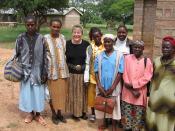HIV in Africa
The HIV/AIDS epidemic has spread rapidly around the world. More that 60 million people have been infected with HIV, and each day, approximately 14,000 new infections occur. HIV is not confined to wealthy and industrialized countries; in fact, the HIV epidemic has had the most severe results in the developing nations of the world. Over 95 percent of people living with HIV/AIDS live in low income countries, where it is difficult to gain access to the necessary medical treatment.
Of all the regions in the world, Sub-Saharan Africa seems to be hardest hit by HIV. AIDS is the leading cause of death in this region, and has reduced the average life expectancy by 10 years. In 2001, 2.3 million Africans died of HIV/AIDS. The epidemic is hardest to fight in this region because the resources and money needed is not available. Although AIDS is most prevalent in this region, only 1.6%
of global AIDS research money goes to Africa.
Because of the widespread effects of HIV/AIDS, it is important that international commitment exists to end the epidemic. AIDS is more than just a public health problem. The epidemic has effects on the development of nations. It can increase poverty, create large numbers of orphans, destroy the workforce, and strain healthcare services. Basic care in Africa for a person infected with AIDS can cost 2-3 times the patient's annual income.
There is no cure for someone infected with HIV/AIDS. However, there are ways to prevent the future spread of the virus. UNAIDS, which is a United Nations agency designed to report on and work against the AIDS epidemic, promotes a comprehensive prevention plan. This plan includes programs to promote behavior change, increase condom use, diagnose and treat "opportunistic diseases", target prevention against high risk groups, and ensure a...



Hiv in africa
You skimmed over the main idea's and didn't go into a lot of profundity. I would have like to hear about some past cases in Africa but besides that good essay
3 out of 3 people found this comment useful.